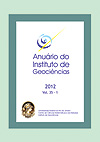Soil quality as geoindicator to trail assessment of the Parque Nacional da Serra do Cipó, MG, Brazil
DOI:
https://doi.org/10.11137/2012_1_199_208Abstract
The trails in natural areas are recognized as a means of travel between the visitor and tourist attractions. Thus, in protected areas, while providing visitors direct contact with nature, visitation results in environmental changes such as, among others, soil compaction and erosion in the bed of the trails. The objective of this study was to characterize soil quality in Farofa Trail, located in the Serra do Cipó National Park, Minas Gerais state, Brazil. The trail, which connects the park headquarters to the natural attraction Farofa Waterfall, located in quartzitic rocky cliff of great scenic beauty, is the most visited and utilized to achieve that natural attraction, besides serving for the practice of hiking, biking, horseback riding and vehicles traffic allowed. This trail offers outstanding environmental impacts of erosion and soil compaction, the latter barely visible to lay observations. To characterize the impact, we performed a survey of soil profiles in the bed of the trail and its surroundings, as well as measures of penetration resistance (penetrometer), using a cone penetrometer with dynamometric ring and collecting soil samples of disturbed and undisturbed soil surface for soil studies. The results show that soils the bed of the trails are compressed relative to adjacent soil and that these need to be managed to promote the conservation of associated biogeodiversity, and its viability as a means of access to the Farofa Waterfall and quartzitic rocky cliff present there, the highlighting the importance of using pedological attributes for the management of trails, encouraging conservation through environmentally sustainable practices.Downloads
Download data is not yet available.
Downloads
Published
2012-06-01
How to Cite
Figueiredo, M. do A., Fonseca Filho, R. E. and Varajão, A. F. D. C. (2012) “Soil quality as geoindicator to trail assessment of the Parque Nacional da Serra do Cipó, MG, Brazil”, Anuário do Instituto de Geociências. Rio de Janeiro, BR, 35(1), pp. 199–208. doi: 10.11137/2012_1_199_208.
Issue
Section
não definida
License
This journal is licensed under a Creative Commons — Attribution 4.0 International — CC BY 4.0, which permits use, distribution and reproduction in any medium, provided the original work is properly cited.















